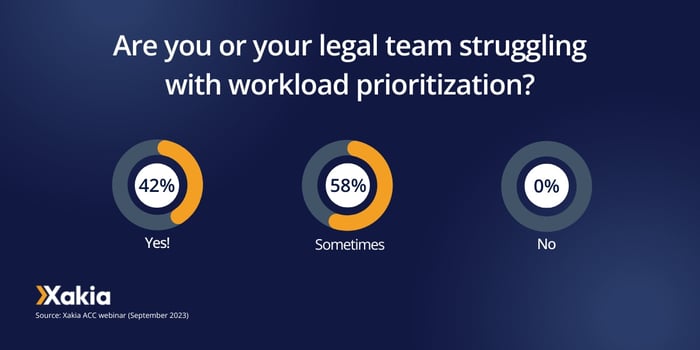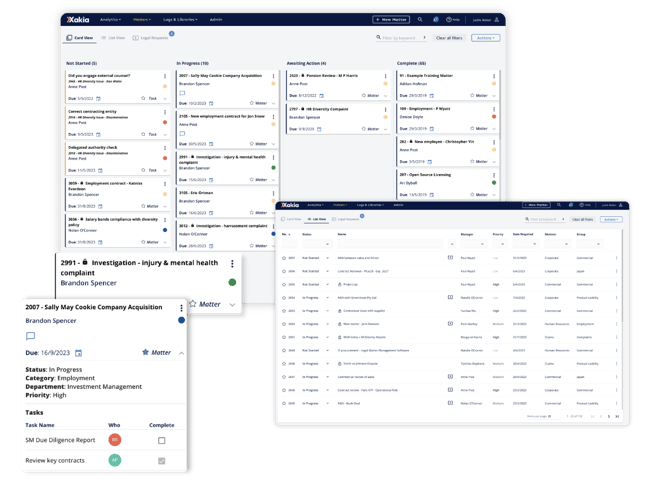Agile methodology which has its roots in software development, has proven beneficial to provide in-house Legal Departments with a framework to manage their work more effectively, enhance collaboration, and deliver legal services that align with the evolving needs of their organization.
In a recent program hosted by the Association of Corporate Counsel Europe, Anne Post, CEO, North America and Dan Wales, VP EMEA took legal teams on a guided tour of the benefits of Agile to build a saner way of working.
The session kicked off with a Xakia flash poll revealing that all in-house legal teams are struggling with workload prioritization. No real surprise there!

In-house Legal Departments are dealing with an avalanche of work and constantly fire-fighting. There is often a sense of disconnection across the legal team and from the team and the wider business with few opportunities for quick and effective collaboration.
To address these three pain points with Agile, we recommend focusing on three key principles:
- Visualize
- Communicate
- Engage
1. Visualize
An Agile methodology promotes flexibility and adaptability. Legal Departments are often faced with a broad range of issues and rapidly changing priorities and an Agile approach allows in-house legal teams to adapt more effectively.
How it works
Utilize a Kanban board in a matter management software to organize and track your Legal Department’s work.

Why you need it
- Clear, visual representation of legal work in progress, making it easy for General Counsel and your legal team to see what tasks are currently being worked on, who is responsible for them, and where they are in the process
- Prioritize and track progress on legal matters to ensure that key legal issues are addressed that align with client needs
- Break down work into the incremental completion of tasks and projects, with regular feedback and adjustments. Smaller, more manageable pieces make it easier to track progress and prevent bottlenecks that overload team members
2. Communicate
Agile emphasizes enhanced collaboration among legal team members and stakeholders. Corporate in-house legal departments often work closely with other departments, such as HR, Finance, and Compliance. Agile can facilitate better communication and collaboration between the lawyer and non-legal professionals leading to more effective problem-solving and decision-making.
How it works
Manage quick, daily stand-ups with your in-house legal team using your Kanban board.
Why you need it
- Move from a ‘laundry list’ to ‘active engagement’
- Short, regular communication
- What have you done?
- What are you doing?
- Identify blockages/resources needed?
- Avoid duplication and identify opportunities to assist

3. Engage
Nobody likes a black box. Agile places a strong emphasis on understanding and meeting the needs of the client to ensure that the delivery of legal services aligns with ever changing client needs.
How it works
Direct, regular engagement through automated regular updates on key deliverables via notifications and legal reports.
Why you need it
- Keep your stakeholders calm
- Empower them to make informed decisions
- Provide the legal team with the information you need to give the best legal advice
- Provide context on prioritization
- Provide early updates on changes to delivery
Key benefits of Agile for Legal Departments
1. Continuous improvement
Agile promotes a culture of continuous improvement. In-house legal teams can use feedback loops to identify areas for improvement in their processes and workflows, leading to increased efficiency and effectiveness over time.
2. Measurable results
Agile encourages the use of metrics and key performance indicators (KPIs) to measure progress and success:
- Who?
- What?
- When?
- Why?
- How?
Legal Departments can use data-driven insights to assess their performance, make data-backed decisions, and demonstrate their value to the organization.
3. Faster Delivery
Corporate Legal Departments often face tight deadlines and time-sensitive legal matters. Agile’s iterative approach can help legal teams deliver legal solutions quickly and efficiently, reducing turn-around times for critical legal advice and services.
While Agile may require some adaptation to fit the specific needs of a Legal Department, there is no doubt that these principles offer valuable benefits in terms of responsiveness and efficiency, particularly in today’s cost-cutting climate where Legal Departments are increasingly under pressure to do more with less.
Get started with Agile and calm team stress levels now!
Watch our Agile for Legal webinar on demand and download the Agile 101 for In-House Legal Departments white paper today to find out how you can increase transparency and improve communication and productivity today.
If you’re a General Counsel or in-house lawyer and you're ready to find a better way way to work, get in touch with the Xakia team now to learn more about our legal matter management software.